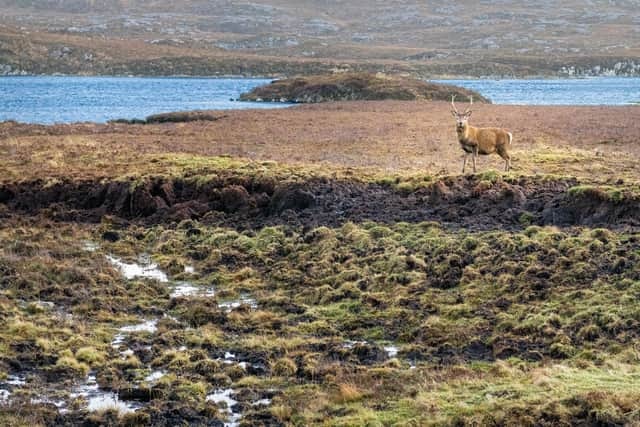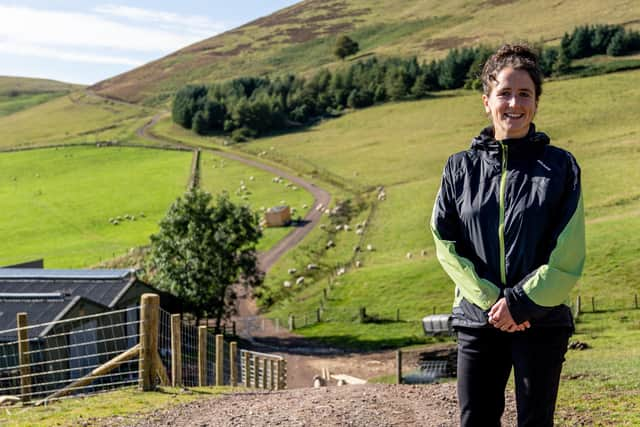Land reform in Scotland: Should foreign ownership be outlawed, what is lotting, is bigger better or do good things come in small packages?
Scotland’s new Land Reform Bill proposes ‘lotting’ of large properties being sold, in a bid to diversify ownership and give local people more power over their communities – but is bigger better or do good things come in small packages?
Scotland has a total land area of nearly eight million hectares, but its ownership is among the most unequal in the western world.
Advertisement
Hide AdAdvertisement
Hide AdThe majority of ground is held in a small number of hands in a uniquely concentrated pattern that has continued virtually unchanged for five centuries – becoming even more extreme in the past 50 years.
Around 12.5 per cent of the country is publicly owned, but it is estimated that just 430 or so landowners – less than 0.01 per cent of the population – control half of all private land outside the main towns and cities.
Meanwhile, the country is facing a housing crisis, especially in rural areas, with young people and families struggling to find affordable homes or land to build them on.
Efforts to address the issue have been ongoing for the past couple of decades but it is a problem that seems hard to solve.
What has been done so far?


There has been change since the Land Reform (Scotland) Act 2003 came into play, with new right-to-buy rules, intended to increase the amount of land held by communities, and strengthening of access rights.
The independent Land Reform Review Group (LRRG) was set up by Scottish ministers in 2012 to identify how land reform might be developed and delivered.
Following the Land Reform Act 2016, the Scottish Land Commission (SLC) was established to drive a programme of reform for both urban and rural areas and create a system where land is owned and used in a fair, responsible and productive way.
It warned ultra-concentrated ownership is damaging life in some places, with a small number of powerful players able to exert high levels of control over the basic needs of local communities.
Advertisement
Hide AdAdvertisement
Hide Ad

A Scottish government project which aims to map who owns every part of the country is due to be completed this year.
What’s happening next?
The new Land Reform (Scotland) Bill was introduced at Holyrood last month, with the aim of changing for the better how land is owned and managed in rural and island communities.
Proposals set out in the draft bill include measures that will mean sales of some large landholdings could be stopped until ministers can consider the impact of the transfer on the local community.
This could lead to some properties – those in excess of 1,000 hectares, which represent more than half of Scotland’s land – being carved up, or lotted, into smaller parts if that might benefit local needs.
The ‘transfer test’ is also intended to increase opportunities for communities to own land through introducing advance notice of certain sales from large landholdings.
Owners of the biggest properties will also face legal responsibilities to show how they use their land and how that contributes to key public policy priorities – such as addressing climate change and protecting and restoring nature.
These owners would also have to engage with local inhabiants about how the land will be used.
Introducing the bill, rural affairs secretary Mairi Gougeon said: “We do not think it is right that ownership and control of much of Scotland’s land is still in the hands of relatively few people.
Advertisement
Hide AdAdvertisement
Hide Ad“We want Scotland to have a strong and dynamic relationship between its land and people.
“We want to be a nation where rights and responsibilities in relation to land and its natural capital are fully recognised and fulfilled.”
She said the bill would “allow the benefits and opportunities of Scotland’s land to be more widely shared”.
So how will new laws affect land sales and ownership?
Proposals in the Land Reform Bill have sparked mixed reactions.
Rural community groups have welcomed the lotting concept but say the trigger level for transfer tests should be much smaller than the 1,000 hectares suggested, so that the needs of local people can be more effectively addressed.
They recommend a much lower threshold – 500 hectares, or even less.
But landowners disagree, warning that carving up large estates could have a detrimental impact on everything from food production to schemes aimed at tackling climate change.
Land reform: How state-owned ground should be used to benefit the people and communities of Scotland
Ailsa Raeburn is chair of both Community Land Scotland (CLS), which supports community land ownership, and Isle of Eigg Heritage Trust, set up to run the island following a buyout by residents in 1997.
Advertisement
Hide AdAdvertisement
Hide AdShe says the Scottish bill must be strengthened if it is to help rural populations to thrive and remain viable.
“It’s great that the Land Reform Bill is being introduced,” she said, “but actually, as it stands at the moment, it will have no real impact at all.
“Lotting is welcomed, but the size thresholds need to be reduced substantially and we need to ensure when the land is lotted that whoever takes the land on afterwards does what they should do with it.”
She added: “In its current form the will not address the issues it was designed to solve.”
This is one thing landowners and community groups seem to agree on.
Stephen Young, director of policy at membership body Scottish Land & Estates (SLE), said: “Land management requires long-term thinking and planning and we need to be crystal clear on what our collective goal is and apply legislation consistently to achieve that.
“Unfortunately, the Land Reform Bill appears to create more uncertainty and muddled thinking rather than the clarity we need.”
He insists lotting could hamper nature-restoration work, tree-planting and agriculture, and says reducing the size of lots to 500 hectares would have a particularly big impact on family farms.
Advertisement
Hide AdAdvertisement
Hide Ad“Public support is provided to support the delivery of a range of public goods,” he said.
“If support was to be withdrawn from certain landholdings then it would undoubtedly come at a cost to food production, woodland creation or peatland restoration in Scotland, as well as the jobs which go along with these crucial economic activities.”
He says the bill “highlights the disconnect between the focus on who owns land and the desire to break up landholdings, the need to tackle fundamental issues that Scotland is facing in terms of the climate and nature emergencies, alongside the need for thriving rural economies”.
Proposals to lower lotting thresholds “do not seem realistic”, according to SLE.
“As Less Favoured Areas (LFA) designation is given to the majority of holdings and agricultural land coverage in Scotland, a 500-hectare threshold would have a disproportionate impact on family farms,” Young explained.
Scotland is in the grip of a ‘carbonanza’, driven by natural capital value and climate goals
In a report back in 2014, the LRRG said it was “not necessarily anticipating a ‘land grab’, similar to the on-going and well documented activity being undertaken by corporations in some developing countries, which is culminating in a huge amount of land holdings being acquired by single companies”.
But since there is currently no legal limit on the extent of land one person or organisation can own in Scotland, the LRRG warned the country could be “vulnerable to interest from wealthy individuals and companies” which could further concentrate the pattern of ownership.
And it seems this story is playing out as we speak.
Sales of land in Scotland have been booming, with potential for tree-planting and restoration of degraded habitats – and the cash that can come alongside – a particular attraction.
Advertisement
Hide AdAdvertisement
Hide AdMany buyers, including international investment giants and ultra-rich business figures, are snapping up ground simply as a financial asset.
Many sales take place off-market, with premium prices being paid.
As a result, locals are being increasingly pushed out and land for essential housing and services is even harder to come by.
Should there be limits on how much land an individual or organisation can own?
SLE says no, because extensive properties can support the most effective environmental projects – particularly crucial as the nation continues to fall short of emissions reduction goals.
“The recent CCC report highlights the stark challenges that already exist in Scotland achieving its climate change targets and sadly the Scottish Government is now pursuing policies that will make progress even tougher,” Young said.
“Delivering peatland restoration and forestry at scale is crucial in achieving the desired levels of carbon sequestration but, as was outlined in research we commissioned last year, we are lagging way behind.
“Our members are undertaking a large proportion of the sequestration and other environmental land management work which is taking place.
“For example, large-scale peatland restoration projects of more than 200 hectares – such as those carried out on rural estates – account for 57 per cent of the 42,300 hectares of peatland that has been restored since 2013.
Advertisement
Hide AdAdvertisement
Hide Ad“Only 25 per cent of the target has been achieved through small-scale projects of less than 100 hectares.
“Of the 45,000 hectares of woodland planted on private land with support from the Forestry Grant Scheme since 2015, almost half of that total was achieved through large-scale projects over 100 hectares.”
He says it “widely acknowledged” by researchers, environmerntal groups and government agencies, including NatureScot, that “nature restoration, climate mitigation and carbon sequestration efforts are most effective when conducted at scale and with the associated efficiencies created where that is under a single ownership and management structure”.
And should there be rules dictating who who can own land in Scotland?
CLS believes there should.
“We need to be much more controlled about who can own land in Scotland,” Raeburn said.
“We are really keen to see a clause in the bill where only entities paying tax in the UK or EU should be allowed to acquire holdings, because obviously they often come with opportunities for grants and subsidies for tree-planting or peatland restoration, that sort of stuff,” Raeburn said.
She fears the appetite for buying up land here will not go away unless barriers are put in place.
“Most countries in the world have some sort of regulations about who can own land and how much they can possess.
“There is nothing in this bill that will restrict who can own land or to restrict how much can be owned.
Advertisement
Hide AdAdvertisement
Hide Ad“Other countries are light years ahead of us in many respects,” she said, “with strict rules on land-ownership.
“We have got people and companies from all over the world eyeing up Scotland, pushing up land prices.
“One of the reasons for introducing the bill was to try to address some of that.
“But the way it is drafted, it won’t.”
Comments
Want to join the conversation? Please or to comment on this article.